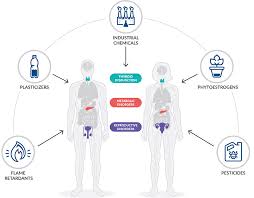Endocrine-Disrupting Chemicals:

Beyond choking oceans and clogging landfills, plastics are now infiltrating our bodies through microplastic particles and a cocktail of endocrine-disrupting chemicals (EDCs).
- The endocrine system is made up of glands that make hormones.
- Hormones are the body’s chemical messengers.
- They carry information and instructions from one set of cells to another.
- The endocrine system influences almost every cell, organ, and function of our bodies.
- Endocrine-Disrupting Chemicals (EDCs) are natural or man-made chemicals that interfere with the normal function of your body’s endocrine system.
- Since EDCs come from many different sources, people are exposed in several ways, including the air we breathe, the food we eat, and the water we drink.
- EDCs also can enter the body through the skin.
- EDCs interfere with the way the body’s hormones work.
- Some EDCs act like “hormone mimics” and trick our body into thinking that they are hormones, while other EDCs block natural hormones from doing their job.
- There are approximately 85,000 man-made chemicals in the world, with at least 1,000 classifiable as EDCs.
- Bisphenol A (BPA) and phthalates are common examples of EDCs found in plastic.




